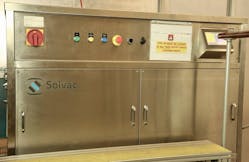Cleanrooms play an essential role in contamination-sensitive applications such as semiconductor fabrication, pharmaceuticals, optics, medical devices/life sciences, and many more. Cleanrooms control the number of particulates in the air (such as dust, microbes, and aerosols) to avoid compromising cleanroom processes and products made there. Standards for these enclosures are tight, especially for motion systems used in them. But following a few basic techniques lets designers use linear motion devices while maintaining an appropriately clean environment.
Cleanrooms are classed according to the number of particles of a specific size per unit volume of space (see table).
To control the size of particulates in a cleanroom, designers filter and minimize the introduction of new particulates from personnel, materials, and equipment.
Controlling particulate generation can be a challenge, particularly when the cleanroom encloses machinery. Micro-lithography, for example, uses slots of robots and other motion devices. Moving equipment that is improperly specified can generate fresh particles. With proper techniques, however, a linear motion devices can support operations in a Class 100 cleanroom as easily as on a factory floor.
Controlling Contact
Linear bearings inherently involve metal-to-meal contact. Ball-style bearings, for example, generate metal fragments by having balls contacting each other as the they roll and turn in their rings. One way to minimize that contact is to enclose and separate the balls in a cage. Ball cages are plastic or polymer structures that maintain separation between balls without altering their friction-reducing capabilities.
As long as the balls are separated by the cages, dust generation will be substantially reduced.
There is a common misconception that ball cages increase prices or leadtimes, but that is not generally the case. For the most common bearings there is no price difference for adding cages. This makes ordering linear guides with ball cages a smart way to increase guide life and improve cleanroom performance.
Preventing Corrosion
Corrosion is another source of particulates. Standard-grade carbon steel oxidizes in the presence of moisture to create rust. This is a concern for applications such as semiconductor and laboratory analytics, which involve reagents, and even manufacturing processes that take place in humid environments. In these types of cleanroom applications, corrosion control measures such as the use of appropriate grades of stainless steel and anticorrosion coatings like hard or black chrome.
Although these measures are effective, they can add significantly to a part’s leadtime. When orders come in for bearings with an anticorrosion coatings, for example, manufacturers do not modify bearings already in stock. Instead, they build the bearings from scratch, coating each element before assembling the them. This typically extends leadtime to several months.
The alternative is to work with local suppliers to disassemble standard bearings, coat, and then reassemble them. The method can substantially reduce leadtimes but must be approached with caution. Working with bearings at this level requires skill and should only be undertaken with experienced technicians who can guarantee results.
Managing Lubrication
A final consideration for cleanroom bearings is the choice of lubrication. Although standard greases are designed to reduce rolling resistance, they can spatter and generate particles. Cleanroom greases are specifically formulated for low dusting.
Getting linear bearings packed with cleanroom grease is not as easy as it sounds. Manufacturers don’t simply pull a stock part from inventory and change out the grease. Instead, when the order comes in, they build a linear bearing from scratch and inject the appropriate grease at the end. As a result, ordering these parts can involve a leadtime of several months. From the OEM perspective, buying a stock part and swapping out the grease seems like a reasonable solution, but it can actually be problematic.
One cardinal rules of lubrication is that greases should not be mixed. Doing so can breakdown the lubrication, damage parts, and lead to premature failure. It is difficult to remove all of the grease from a caged bearing before replacing the grease. The process typically requires special degreasing tanks to remove all residue.
Trust Your Vendor
Cleanroom applications are typically high-value operations with a high costs for downtime and scrap. To protect operations and maximize operation equipment expenses (OEE), specify linear bearings that can operate in cleanroom environments. Minimize dust generation by choosing caged bearing guides and specifying corrosion resistant components where appropriate. Be sure to use cleanroom greases and take advantage of local expertise to minimize leadtime. Most important, work closely with your vendor to ensure you make the best choice of components and processes to ensure the success of your application.
Alex Polo is a sales engineer and linear motion specialist at Motion Solutions.





